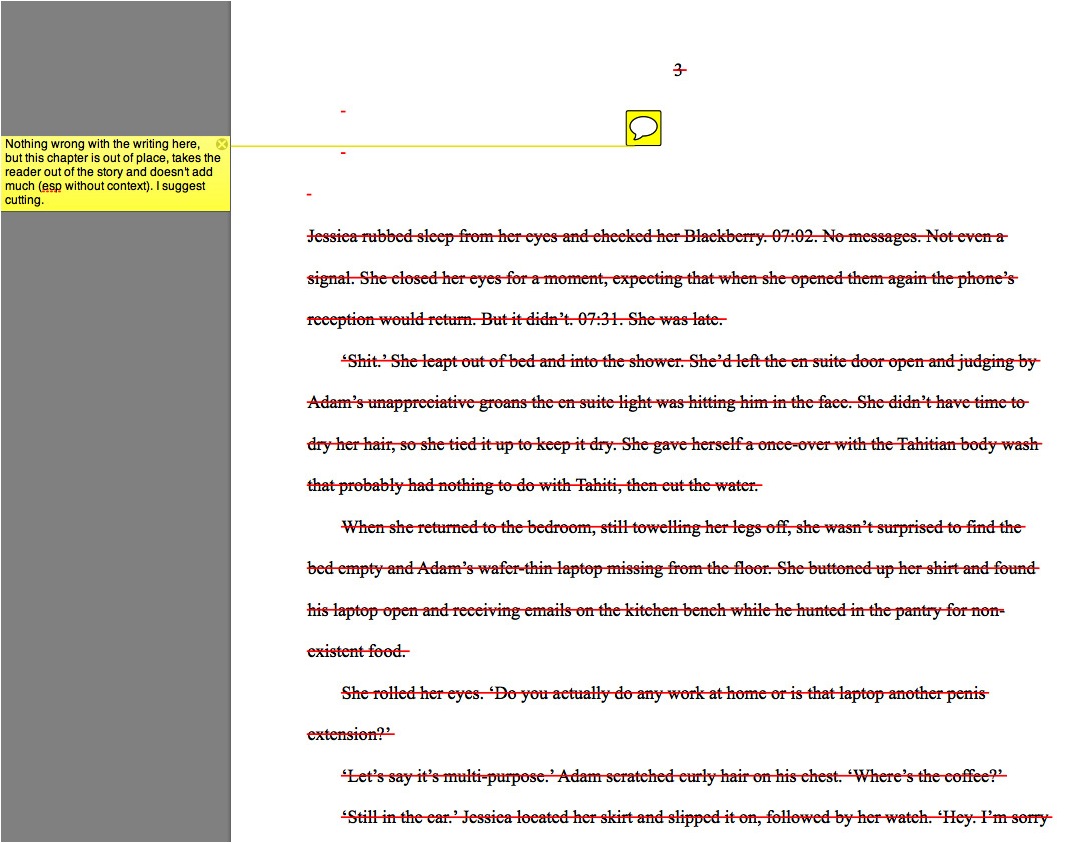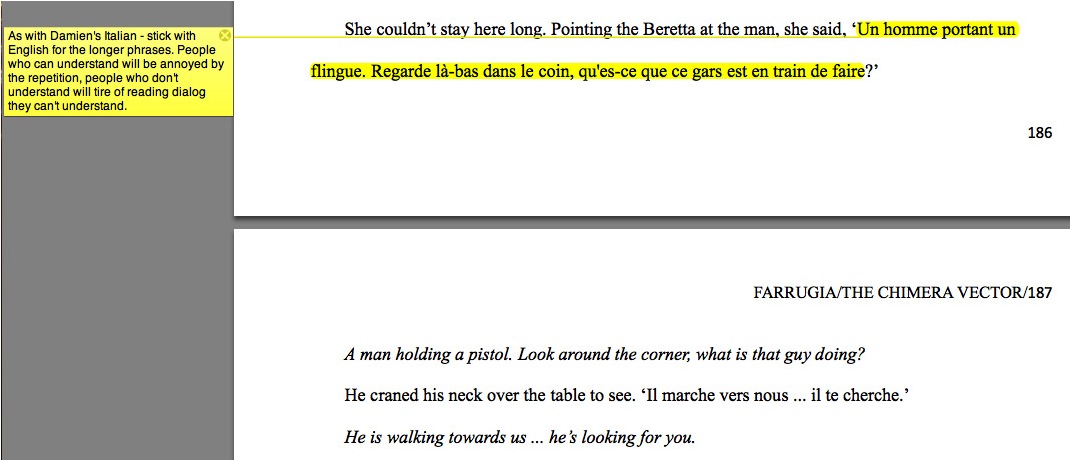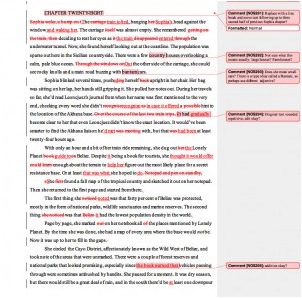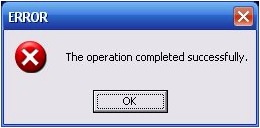Where Nathan Farrugia talk about editors, Scrivener and the INTERNETS.
In today’s post, I’m going to share what it’s like to have your novel edited. By a publisher. Or what it’s like to wax your inner thighs. No, just kidding. The editing is much more fun. And I never waxed my inner thighs, I don’t know what you’re talking about.
I thought it might be fun or annoying or annoyingly fun to have this blog post edited. Before your very eyes. Like real magic. See the red text, highlighted text and crossed out words? That’s one part of the editor’s job: the “line edit”.
So to do this properly I’m going to share with you my editorial report and some annotations my editor wrote in my manuscript. While this means you get to see all my mistakes and sloppy writing, it’s also a great way to see the insides of the book making process! [I’m giving you one exclamation mark for the whole piece. And that’s generous.] And this is why I think there aren’t many blog posts about this. Because writers are a bit reluctant to reveal their pre-perfect writing.
Oh noes, no one can see my book before it’s perfect! – author of Twilight
[To be accurate, the author actually said she was “too sad” to continue work on the book and said she was putting its completion “on hold indefinitely”. But I like your quote better.]
What if they find out how much I suck? – Paranoid vampire
“The first draft of anything is shit” – Ernest Hemingway [fact check: quotation]
Having had no prior experience with an editor, I must say I was impressed with the thoroughness that goes into the editing process. Many authors underestimate the role of the editor, and some — eager to self-publish on Amazon — skip it entirely, or substitute it by giving it to friends to read instead. If your friends can give you honest, blunt feedback, great! But they aren’t editors and unfortunately can’t substitute for one.
As I discovered, editors don’t just read your manuscript once. They read it three times. In each pass, they write more comments and adjust their initial comments. My 450 page Word document came back with 425 comments.
What types of edits are there?
Phase one is the structural (or content) edit. This phase involves the editor working with the author on the structure of the manuscript: the plot, the characters, the setting, the pacing, the logic of the world in which the story is set. To ensure that all the shit makes sense.
Xavier, my agent, once said to me, ‘So many manuscripts land in my inbox where the plot hinges entirely on the stupidity of the characters. At all times this is what you should be working to eliminate.’ Unfortunately, many writers storm off in a huff, never to be heard from again. But a rare few (too rare unfortunately, in Xavier’s opinion) swallow their pride, acknowledge that their draft currently sucks [no more suckage. Really] and needs work.
I know this because I was one of them.
He was of course talking about plot holes. And phase one is where you make your plot holes your bitch. And iIt can take several rounds of going back and forth between the author and the editor before phase one is complete. Sometimes this can take place before a contract is even signed.
And in Sometimes Land there is an in-between phase known as the line edit. This is when the language, sentences, repetition and pacing are cleaned up line by line. (Here in Australia, this is often merged into phase two.)
Phase two is the copy-edit. Once everything is structurally sound and the story does not suck [What did I say about suckage?] or other ball-related objects, the manuscript is passed on to the copyeditor like a game of pass the parcel and the copyeditor will look at language, style, sentence structure, expression, spelling, grammar, punctuation and your underwear drawer. The copyedit is the nuts and bolts of the editing process, it is intensive and detailed and did I mention intensive?, aAnd it is what gives the manuscript a professional finish.
The editorial report
But what does an editorial report look like? Well I’m glad you asked (you didn’t). My complete editorial report is available on my blog, along with a more comprehensive version of this article: http://www.nathanmfarrugia.com/im-in-ur-writin-makin-it-moar-bettr/
My editorial report gets down and dirty, into specific issues. Here is one example:
PLOT
The plot of The Chimera Vector races along so quickly that I could, at times, literally feel my heart beating faster. That takes some damn fine writing skills, and I applaud you for it. However, there were a couple of plot points that felt a little bit undeveloped, as if perhaps they were added in and then forgotten. This may not be the case, especially given you are planning to write more books in the series – but I’ve detailed them here for you to review.
Sophia’s Synesthesia
I really like Sophia’s synesthesia, especially early on. However, as the story develops it becomes a bit distracting – taking away from the descriptions of the places and people she sees, and I couldn’t help wondering why it was added in – as it doesn’t seem to serve the plot.
One thing about the first phase of editing, the structural phase: the editor does not actually do the work for you. They are not the co-writer. But their report and their suggestions will help you to make the changes yourself.
Anyway, here are some more annotations for your viewing pleasure.
(Sidenote: my blog editor got distracted by The Muppets on YouTube, so no more bold text from here on out.)
Oh look, an unwelcome cliché:
And a point of view suggestion:
A suggestion to cut an entire scene:
Or write a new one:
Remove some cumbersome language:
Edit Like A Boss:
And in case you’re feeling inundated with the negative annotations, a nice sprinkling of praise to keep you going:
Scrivener
While all of this work would ordinarily be done in Microsoft Word, I actually did something completely different. I knew there were a few scenes that needed to be swapped around, shuffled, moved earlier or moved later on, and some scenes written completely from scratch. To do all of this in a word processor is a bit of a nightmare. Jumping back and forth, getting confused as to what I put where, losing track of the overall flow of the storyline, all the stuff that brings a writer to their knees, weeping tears of despair into their gin. But not so. Not when you have something like Scrivener at your disposal. Shuffling stuff around in Scrivener is so easy. SO EASY.
LIKE PLAYING MINESWEEPER IN GOD MODE.
I imported my entire manuscript as an RTF file into Scrivener, complete with comments. I did the in-line editing in Word first, because I wasn’t sure if Scrivener could handle that. And then I broke the manuscript up, chapter by chapter. This was a bit tedious, but once you know the shortcut to create a new break (command + K), you can break up 100 chapters in under 10 minutes. I named each chapter, mostly to make it easy on myself, and color-coded them according to the character’s point of view. LOOK SO PRETTY.
And before I knew it, the structural editing was all done and the manuscript was whisked off to PHASE TWO for the copyeditor to work her magic. And if you’re curious as to what this magic might look like…
COME AT ME, BRO
Think of your manuscript as a really good head of hair. The editor is your hair wax. Wow, that’s my worst analogy ever. OK, let’s try again: think of your manuscript as a computer program and the editor as the debugger. They will test and discover every flaw, bug and error in the manuscript they can find.
Because no one wants you to release Windows 98 again.
The full version of this article can be read at www.nathanmfarrugia.com.
The Centre is running the Essentials of Editing starting 19th of April.














